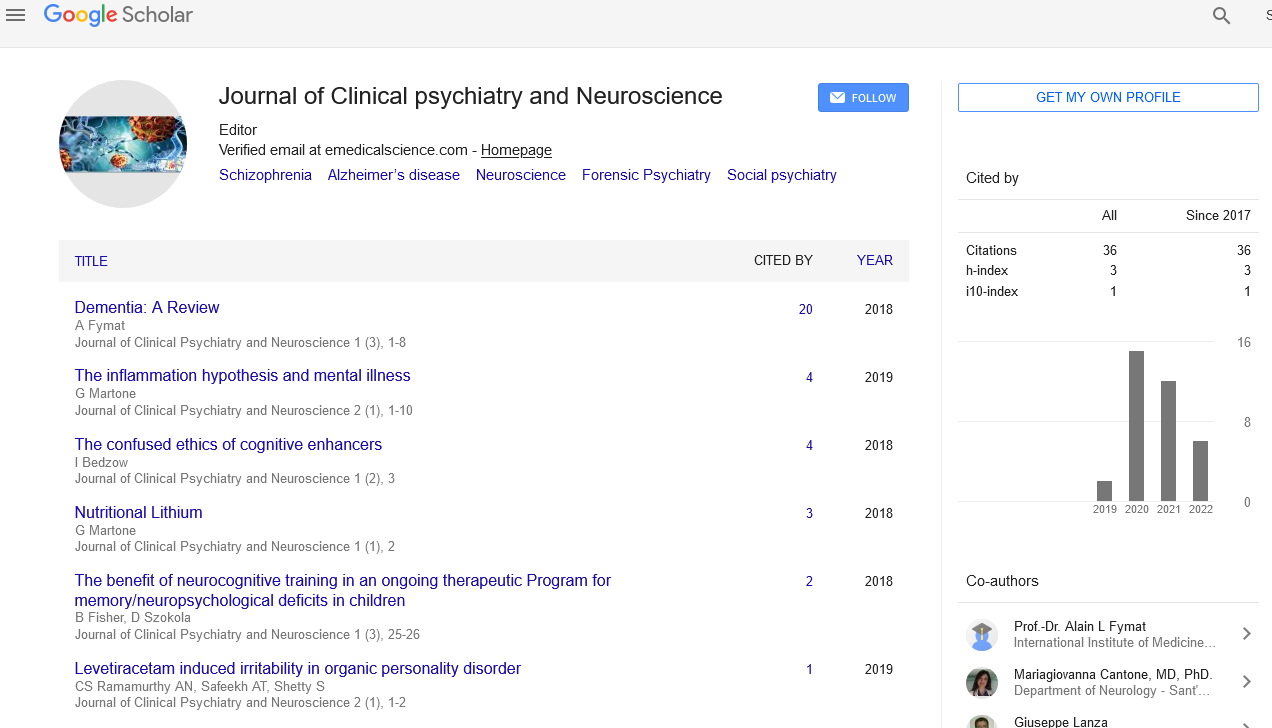Short assessment on molecular imaging in neuropsychiatry
Received: 04-Mar-2022, Manuscript No. PULJCPN-22-4874(M); Editor assigned: 06-Mar-2022, Pre QC No. PULJCPN-22-4874(PQ); Accepted Date: Mar 25, 2022; Reviewed: 19-Mar-2022 QC No. PULJCPN-22-4874(Q); Revised: 22-Mar-2022, Manuscript No. PULJCPN-22-4874(R); Published: 28-Mar-2022, DOI: 10.37532/ puljcpn.2022.5(2).15-16
Citation: Ran W. Short assessment on molecular imaging in neuropsychiatry. J Clin Psychiatry Neurosci. 2022; 5(2):15-16.
This open-access article is distributed under the terms of the Creative Commons Attribution Non-Commercial License (CC BY-NC) (http://creativecommons.org/licenses/by-nc/4.0/), which permits reuse, distribution and reproduction of the article, provided that the original work is properly cited and the reuse is restricted to noncommercial purposes. For commercial reuse, contact reprints@pulsus.com
Abstract
This article centers around cutting edge sub-atomic imaging strategies, as applied to the most difficult indicative and restorative issues in brain research and nervous system science, and shows the basic job of sub-atomic mind imaging in seeing neurobiological instruments and in possibly educating the improvement regarding more successful medicines.
Keywords
Neuropsychiatry; Synapses; MRI; Neuroinflammation
INTRODUCTION
The beyond twenty years have seen amazing advances in radiotracer science for Positron Emanation Tomography (PET), as well as systemic advances for Magnetic Reverberation Spectroscopy (MRS) that gives corresponding data to PET imaging. Radiotracer improvement has made conceivable the examination of chemicals, synapse union/digestion, carriers, and receptors for an assortment of synapses and neuromodulators (counting second couriers and neuropeptides) in the living mind. A significant concentration throughout the last ten years has been in-vivo imaging of neurodegenerative sickness components that already could be concentrated distinctly at after death assessment, including aggravation, beta-amyloid, and Tau proteins. MRS gives a remarkable chance to concentrate on amino corrosive synapses (GABA, glutamate), and proportions of neuronal digestion and oxidative pressure. Late advances incorporate altered MRS, which has brought about more exact evaluation of synapses and metabolites at lower field strength that can be performed even in multi-site studies, as well as high field strength MRS imaging.
In corresponding to progresses in PET radiotracer science, advancements in instrumentation have significantly worked on the spatial goal of PET. The high-goal research tomograph is a committed human mind PET scanner with a goal of 2.3 mm-3.4 mm. The advancement of double methodology imaging has been one more significant development in instrumentation, including PET/figured tomography scanners and PET/Magnetic Reverberation Imaging (MRI) scanners. Successive imaging of construction and capacity and, all the more as of late, synchronous obtaining of design/hardware and capacity. Concurrent PET/MRI is a significant chance to study pharmacologic as well as conduct instigated changes in brain hardware and explicit neurobiological instruments. The creator talks about the difficulties of leading neuroimaging research in ASD. They present the significant MRS and PET neuroimaging discoveries, including their own significant commitments. MRS investigations of GABA and glutamate and PET investigations of dopamine, serotonin, glucose digestion, and cerebral blood stream are audited. The outcomes introduced highlight the need to grasp the neurobiology of ASD across the life expectancy, as well as to relate the sub-atomic imaging discoveries to symptomatology in bigger patient examples. While persistent schizophrenia has been a significant focal point of the sub-atomic imaging research, the investigation of people at clinical high gamble for schizophrenia has been more restricted. Researchers have performed creative sub-atomic imaging investigations of early psychosis, including concentrating on people at clinical high gamble for schizophrenia and first episode psychosis. This difficult area of exploration is basic to recognize atomic focuses on that might modify the early direction of psychosis and may have suggestions for understanding the co-horribleness among psychosis and substance utilize that might adversely affect psychosis chance and course. In their audit, the creators center on imaging of extra-striatal dopamine, neuroinflammation, glutamate, GABA, and endocannabinoids. Significantly, they talk about future applications to concentrate on clever systems, for example, other endocannabinoid targets, synaptic thickness, and nociceptin receptors, in light of ongoing advances in radiotracer science.
The job of the Hypothalamic-Pituitary-Adrenocortical (HPA) hub is deeply grounded in Post-Horrendous Pressure Problem (PHPP), and has been valued as of late in substance use issues and their co-horribleness with PTSD. As PET radiotracer improvement for the HPA pivot has been testing, human investigations have zeroed in on fringe biomarkers (for example cortisol, corticotrophin delivering factor). Some researchers have performed robotically original atomic imaging concentrates in substance use. They audit the pre-clinical proof for HPA hub brokenness in substance use issues and PTSD, as well as the pressure and hostile to stretch frameworks in the mind, with an attention on the counter pressure peptide, nociceptin. The nociceptin receptor (NOP-1A) has been involved in liquor use issues and PTSD in creature models. The NOP-1A receptor can now be concentrated in the living human cerebrum with an as of late evolved PET radiotracer. Further, the NOP-1A receptor can be assessed as a likely restorative objective in vivo. The creators present their promising outcomes and examine future utilizations of this novel radiotracer to understanding substance use issues and PTSD co-bleakness.
CONCLUSION
Researchers have additionally talked about the utilizations of MRS to understanding mind-set issues in late life, which are related with expanded mortality, dreariness, and chance of dementia. MRS studies have made significant experiences into instruments like oxidative pressure, mitochondrial brokenness, irritation, and synapse brokenness that might address a neurobiological connection between disposition problems and mental deterioration, and may act as biomarkers of these cycles. The creators and their associates have performed inventive MRS concentrates in late life sorrow and geriatric bipolar issue, including assessing extraordinary neurobiological systems of antidepressants or impacts of novel medicines. These examinations have shown that the biochemical modifications might have utility for determination and treatment reaction in these circumstances, and that concentrates in more seasoned age associates require further examination.





